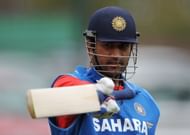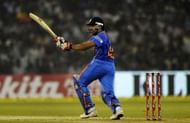If ever there was a doubt in Cheteshwar Pujara’s credentials as a Test specialist, it has been put to rest once and for all with the just concluded Test series against South Africa.
When it comes to the One-Day internationals, the popular notion is that he is being ignored due to fitness issues – a myth which I try to dispel here besides adding why it is entirely preposterous to buy into this whole idea of ‘Pujara needs to be preserved for the longer format’.
There are a couple of events which need to be revisited to make a case for establishing the fact that Pujara is not being sidelined for fitness issues.
Case 1:
First up, the One-Day international series against England in India in January, 2013. It was during this series that Pujara was first drafted into the ODI squad, at the cost of a misfiring Virender Sehwag.
The selectors dropped a hint by specifically stating Pujara could bat at any position where the team wants him to and added that a batsman of his calibre would be required keeping in mind the new changes to the format (new balls from either ends).
With Gautam Gambhir not in the greatest of form, no back-up opener in the squad and Ajinkya Rahane not making the most of his opportunities, Pujara was expected to make his debut at some point of time during the 5-match series.
As anticipated, the openers failed to deliver. Rahane was the first one to make the way. It was then the Indian captain MS Dhoni pulled the rabbit out of the hat by promoting Rohit Sharma as the opener.
The decision hardly made any sense as Rohit was a proven failure at that point of time and the gamble to play him as an opener had backfired terribly during India’s tour of South Africa in 2011, when he was woeful against the moving ball. Yet, Dhoni chose to give a chance to a batsman who had 80+ opportunities previously to show he had nothing to offer ahead of someone who was technically better and had not been given a single shot at the international level.
The Mumbai batsman has since then filled in the role admirably well. While I would not call the move as a success till he delivers outside Asia, to his credit Rohit has all along been displaying excellent temperament. I still stand by my stance on the ploy – Rohit ahead of Pujara was not wise at all, but miracles do happen.
And no, the Champions Trophy 2013 in England cannot come to his defence. The ball did not move around an inch, did it? Not just in India’s matches, it was pretty much the case throughout the entire duration of the tournament, which played into India’s hands big time. Just because the matches were played in England doesn’t mean it needed to be only on alien pitches.
So it stands, Rohit has to deliver outside the sub continental conditions to justify Dhoni’s decision making as it came at the expense of pure quality of Pujara and the career of few other equally deserving players like Manoj Tiwary and Subramaniam Badrinath.
It would be fair to say that the selectors played their ace in Pujara but Dhoni completely ignored it. We will soon find out who stands to lose because of that decision. I will come to the conclusions on the fitness issues of Pujara in relation to his selection after presenting my second case.
Case 2:
Dropped right away from the very next series, 6 months later, the national selectors pushed for Pujara for the second time in a year during India’s tour of Zimbabwe. Dhoni was not a part of the travelling team as the selectors had opted to rest him.
Finally he made his debut in the fourth match, after India had won the series 3-0. Unfortunately, he failed to capitalise on the two chances with scores of (13 and 0) and has since then been out of contention.
So here are the nagging doubts that arise from the two cases:
• If Pujara’s fitness is such a serious concern (as is being believed) to not even consider a player of his quality for the ODIs with the World Cup 2015 in challenging conditions, why was he then selected at first hand not once but twice not so long back as the first replacement (no back-up opener on either occasions)?
• Haven’t the team physios made Pujara’s fitness concerns (if any) that can cut-short his career if he plays ODIs (as is being feared), clear? If they are not expected to volunteer, are selectors so reckless to not know about a player’s full background before going for his selection?
• The person who best knows about Pujara is the player himself (in consultation with his personal medical team and the team’s as well). Why hasn’t he come forward to say in public or in person to the selectors that he would stay away from other formats to reduce the work load? Is he risking his future by getting along with it despite knowing that his only dream, which is scoring runs self-admittedly, could very well be shattered if he pursues other formats?
I hereby assume that the questions raised above would be enough to make the fitness factor fall flat unless you take the group of physicians, selectors and Pujara to be unprofessional or callow.
So what then keeps Pujara out?
It is well known that, in most cases and most certainly in India, while the selectors are in charge of picking the 15-member squad, the captain and the coach are normally given the complete rights to choose the playing 11.
There appears to be a difference in opinion between the two sides, as despite the fact that the selectors are pushing him in, the captain and the coach continue to ignore him. It went to an extent that Dhoni was prepared to promote someone like Rohit, who had botched almost all of his chances till that point of time, ahead of him.
Now that he is not even in consideration, have the selectors come to a conclusion that it would be better to include a player whom their captain would at least play than someone whom he doesn’t place any trust in?
So, I believe looking at this way is more reasonable than looking from the fitness point of view, which has a lot of loop-holes.
Why does MS Dhoni ignore Pujara in ODIs?
Well, we all know Dhoni believes in having agile fielders and part-timers in the team. Rohit Sharma is one of those players whom Dhoni rates very highly and he fits both the above-mentioned criteria while Pujara is neither a telling presence in the field nor a part-time bowler. So, that should have been the reason why the captain might have gone ahead with Rohit. Simply put, Pujara does not bring what MSD expects in his team.
The number 4 and number 5 spots are vacant. So why is Pujara still not being considered then? The number 5 spot answers for itself. Pujara doesn’t fit there at all. The number 4 is more of a 50-50. While he could very well be a success story, I would not fault with anyone who thinks it is not the right way to go as when the 2nd wicket falls late, say into the 25 th over, his skills cannot be completely utilised.
Ideally he should be a one-down batsman. But we have arguably the best player in the world at that spot and that leaves opening as the only vacant position, one where Dhoni’s gamble paid-off big time and shut the door on Pujara.
Yes, Pujara cannot be flexible in the field but with the new rule bringing in 5 fielders inside the circle, for the kind of quality he brings to the batting unit, you can afford to hide him in the field especially when he plays with a pretty good fielding unit.
What do we do with Rohit then?
Bring him back to number 4. While the improved version may not be enough to face high-class swing bowling upfront, as shown in the recently concluded South Africa tour, the temperament will come to his rescue down the order.
Sample this, Rohit can struggle big time facing up to Dale Steyn and Mitchell Johnson but will have his life easy against Wayne Parnell and Clint Mckay. Also, this solves one more of India’s problems which is the hunt for the number 4 in the absence of Yuvraj Singh.
Let me conclude by giving the final touch which could shed more light into why I think this whole idea of ‘reducing the workload’ concept doesn’t make sense at all.
Pujara has so far played 91 First-Class and 68 List A matches. Take this in comparison with Rohit, who has been a part of 62 First-Class and 181 List A matches.
The extremely injury prone (or so believed to be) and bedridden (okay, not bedridden obviously but that is the extent to which his injuries are being hyped) doesn’t lag behind by much in comparison with the fitter Rohit, when you take into consideration that Pujara has 29 more four-day matches to compensate for 113 extra list A (one day fixtures) appearances from Rohit. Also, Pujara has played 17 Test matches in addition to it as against Rohit’s 4 Tests. Not to forget, he is a year younger than Rohit.
Pujara, who has made it clear that he wants to be a part of the One-Day side, will be leaving no stones unturned till he makes it. So, it is not like he is going to be resting when he doesn’t play Test cricket for India. The 26-year-old is ready to pounce on every little opportunity that comes his way to maximise his playing chances for the Indian ODI team. So, he doesn’t play lesser amount of matches in any case.
It is not like he is picking and choosing matches to keep himself fit. Unless it is conveyed to Pujara that he needs to stop pushing for a place in the ODI side, there would be no real use in restricting him to Test cricket. More so, when the next two World Cups are scheduled in Oceania and England.
Oh, and we haven’t even discussed about the Indian Premier League. Why not stop him there too? That I would not bother, as I do not see him as a T20 player.
Brand-new app in a brand-new avatar! Download Cric Rocket for fast cricket scores, rocket flicks, super notifications and much more!


